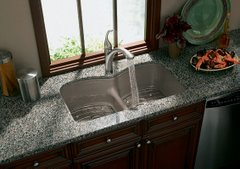Material
Kitchen sinks are manufactured using many different materials. Just to name a few, stainless steel, enameled cast iron, porcelain on steel, Corian, quartz composite, granite, and vitreous china can all be found in today’s modern kitchens. Despite this wide variety of options, stainless steel has emerged to become the most popular choice for new installations. Moreover, cast iron remains the material of choice for consumers seeking a colored finished. Below are descriptions of various materials:
·
Stainless Steel: As noted, stainless steel has emerged to become the most popular choice of materials for new sink installations. This is due to its low cost, lightweight, and almost unbreakable construction. It is important to note that various qualities of stainless steel exist. For example, light-gauge stainless steel that is higher in number (20-gauge, etc) is more susceptible to denting and scratching. Furthermore, stainless steel is also available in a mirrored finish. This gives it a shinier appearance, but also increases the likelihood that visible scratches will occur. Brushed-stainless (also called “satin”) finishes are the newest trend because scratches are less visible. Also popular are satin bowls with mirrored rims.
·
Enameled Cast Iron: Enameled cast iron is the optimal choice if you desire a fashionable, colored sink. The material itself is comprised of a solid cast iron base that is layered with a deep enamel surface. This makes for an extremely heavy construction that is resistant to almost any type of structural damage. Consequently, enameled cast iron is more difficult to install and tends to cost more than porcelain or stainless steel. Nevertheless, it will save you money in the long run because it should last forever.
·
Porcelain on Steel: This material is made by combining an embossed steel casing with a layer of a specially, glazed clay. This creates a smooth and appealing surface that will remain strong if the sink is used normally. It is relatively lightweight, and thus, cheaper than many other materials. However, if a large object is dropped into the sink, and subsequently causes a big impact, the sink may damage. Furthermore, the sink tends to produce a good amount of operating noise.
·
Corian: Natural minerals and acrylic resin are processed together in order to fabricate this material. It is similar in construction to granite, but is cheaper and able to be fixed in the event that it breaks. It’s durable and easy to clean. However, it is susceptible to scratching by corrosive fuel based products and metal objects, if they are left on the surface.
·
Quartz Composite: This material is very similar in composition to corian, except that it has a smoother surface. A quartz sink is resistant to the everyday wears of a normal kitchen operation, including hot pans. Furthermore, the surface insulates dishwater and keeps it warm for longer periods of time, making it easier for you to wash your dishes. Quartz is available in almost any color and will not fade because the color runs throughout the entire material. The main reason why people don’t like quartz is because it does not have a shiny finish.
·
Granite: Extremely high price tags are attached to these types of sinks, which are the most scratch resilient sinks that can be purchased today. This durability can be attributed to the compactness of rock particles that coat the surface. As is the case with quartz composite, this material is not available in a shiny finish.
·
Vitreous China: A ceramic-based material, vitreous china is best recognized for its smooth and glossy finish. The material is very durable and is available in almost any color, including hand-painted and sculptured designs. Unfortunately, boiling water or heavy objects that fall into the sink can damage the surface.
2/09/2007
Sink-ology (What are the different types of material kitchen sinks are made of?)
Labels:
cast iron,
corian,
granite,
kitchen sink,
stainless
Subscribe to:
Post Comments (Atom)


No comments:
Post a Comment